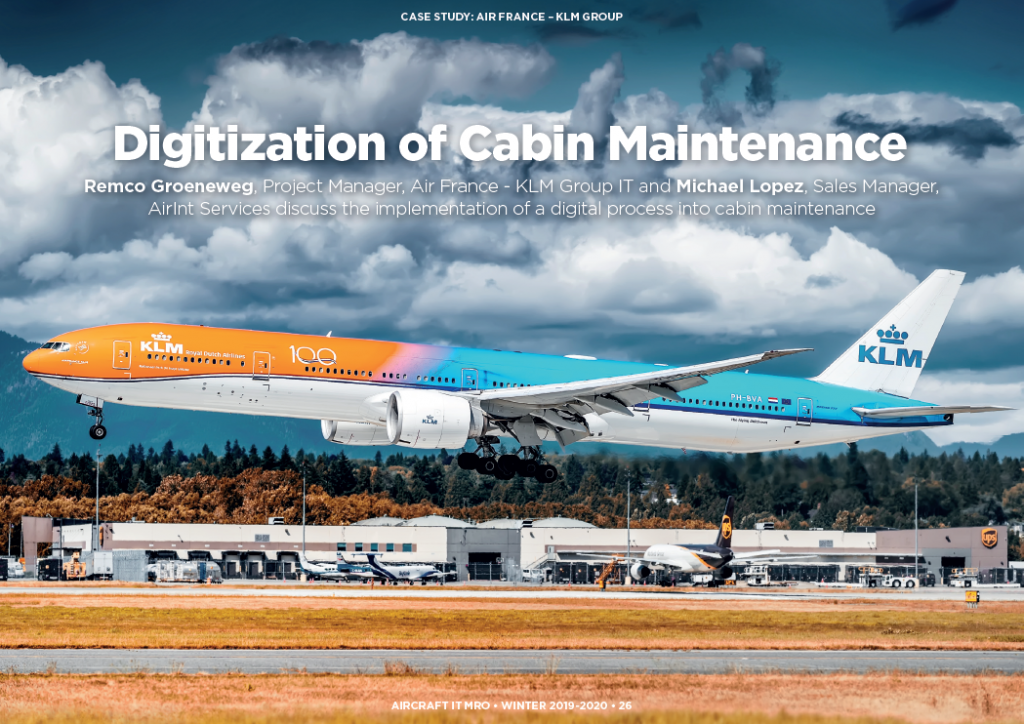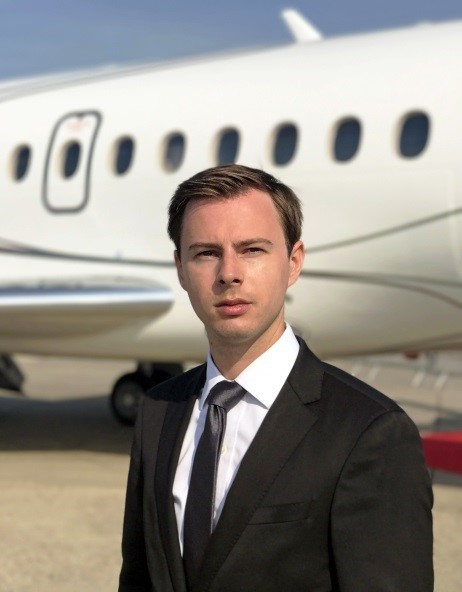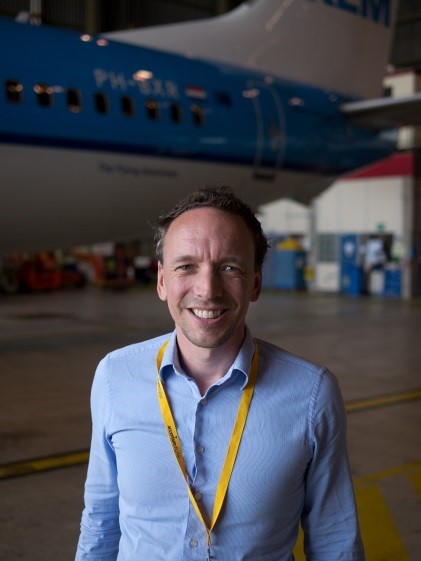Articles
| Name | Author | |
|---|---|---|
| How I See IT: What’s in your solution blueprint | Allan Bachan VP, Managing Director, MRO Operations, ICF. | View article |
| Teaching machines to better identify chronic defects | Mark Langley, Chief Technology Officer, ATP CaseBank | View article |
| Artificial Intelligence Applications and Advanced Analytics in Aviation Operation | Jahan Alamzad, President, Laminaar Aviation InfoTech Americas, Inc. | View article |
| Case Study: Air France – KLM Group – Digitization of Cabin Maintenance | Remco Groeneweg, Project Manager, Air France - KLM Group IT; Michael Lopez, Sales Manager, AirInt Services | View article |
Case Study: Air France – KLM Group – Digitization of Cabin Maintenance
Author: Remco Groeneweg, Project Manager, Air France - KLM Group IT; Michael Lopez, Sales Manager, AirInt Services
Subscribe
Remco Groeneweg, Project Manager, Air France – KLM Group IT and Michael Lopez, Sales Manager, AirInt Services discuss the implementation of a digital process into cabin maintenance
Our topic for this article will be cabin maintenance and, particularly, the benefits in going digital in the execution of that process. We have decided to present this in the form of questions and answers with Remco speaking for the digital specialist and Michael asking some questions. But first, we’ll introduce ourselves. Remco Groeneweg is Project Manager in Air France KLM Group IT with a focus on engineering and maintenance. Michael Lopez is Sales Manager at AirInt Services.
Looking at the two companies, readers will already know Air France KLM with its passenger and cargo businesses as well as the Engineering & Maintenance business (AFI KLM E&M). That AFI KLM E&M business maintains fleets within the group, some 500 aircraft, making it one of the larger MROs in the world. Innovation is always an important focus for the business and is driven with the MRO Lab. On its side, AirInt Services is a rising French company based in Bordeaux and Paris, specializing in providing digital maintenance solutions for airlines and MROs.
So, on with the questions and answers…
Michael Lopez: Perhaps it would also be useful, Remco, if you could first give us an overview of the current situation for and challenges that airlines are facing today.
Remco Groeneweg: As readers will well know, airlines operate in a very competitive environment today. There is a constant focus on improving the product and improving the service while, at the same time, there is an obligation to reduce costs and maximize fleet availability. Airlines are seeking to deliver the best product to their customers at the lowest cost base by…
- Offering great quality products and services;
- Providing the best in-flight experience;
- Meeting passengers expectations in order to gain customer loyalty;
- Maintaining high cabin quality standards;
- Reducing MRO costs; and…
- Optimizing fleet availability.
This is the environment in which airlines work and Air France KLM regularly launches a number of initiatives to make improvements on every front.
Michael: Following that brief scene setting, let’s move to the main topic of cabin maintenance and how can digital help the issues and challenges in that process.
Remco: What we see here is that, in order to offer better products, Air France KLM is installing increasingly sophisticated equipment in the cabin with Wi-Fi, new types of seats, etc. With greater electronic content, and more connectivity, the cabin is becoming increasingly complex. However, with that sophistication and complexity, the equipment is also increasingly challenging to maintain. It’s getting increasingly difficult to find correct part numbers (often abbreviated PN or P/N) with the newer fleet and newer equipment. Maintenance operations are neither optimized nor reliable but they are time consuming.
Michael: From the experience at AirInt Services which has grown out of cabin maintenance, it was seen that cabin maintenance processes were not really optimized most of the time, sometimes they were not reliable and, as Remco was saying about part numbers, readers will be aware of how many thousands of part numbers there can be in the cabin which made it really time consuming for the technicians performing the cabin inspections. So, Remco, what did Air France KLM do to find a solution to this challenge?
Remco: In brief, we’re going digital and the Cabin App is one of the initiatives plus a larger program which I will further explain below. With cabin maintenance, we were looking for a partner and a tool, in which we were inspired by our Air France colleagues who had started with the tool.
Michael: When AirInt Services started working with Air France KLM we tried to find some common objectives and targets as listed in figure 1.

Figure 1
First, go digital: when the transfer to digital is made, moving from a pen and paper process to a tool such as an iPad or any tablet device, you will have moved to digital and paperless. Our objective was to simplify the inspection and defects reporting. Also to help to identify P/Ns faster so that cabin repairs could be undertaken and completed sooner. Another objective was to reduce cabin maintenance time and, where possible, cost. Also important was to be able to deliver accurate and reliable data: that’s very important and, with the App, it’s possible to get a full traceability of data and any actions that are performed in the cabin. And finally, it was important to maximize cabin assets.
We’re not sure whether all readers will be familiar with cabin maintenance but we can compare manual maintenance processes to digital (figure 2).

Figure 2
In the figure, you have two summaries of all the different steps that a technician must perform to first find a defect and then right through until that defect has been repaired. So, from the maintenance status, we can identify what kind of defects there are then go into the aircraft to do an inspection with a pen and paper to note down all the information. Then, the technician will have to go through the CMM (Component Maintenance Manual) document to find the information they are looking for which is the part number. When they get the part number, they then analyze it all, report all of this into the IT system, then go to logistics to see whether they have the spare part to repair the cabin, going back to the aircraft to make the repair. Next, again using pen and paper, the technician must record in the ERP system that the repair has been corrected and the defect can be closed… it is a lengthy process – perhaps up to five hours.
Using the App that Air France-KLM wanted, it’s possible to eliminate all of those tasks considered as non-added value tasks for the airline, leaving the technician able to focus on two things: to identify the defects sooner and to repair the defects faster. In the figure, all the steps that are deleted (red cross X through them) are deleted because all the information now comes from the iPad and the Cabin App. So, instead of the technician having to go for the information needed, the information that they are looking for is brought to them.
To add some figures to that, we observed at Air France when performing an inspection of, for example, economy class seats on a Boeing 777, it was taking two people more than five hours to get the full list of defects with correct P/Ns. With the Cabin App, one person can get the full list of defects in less than two hours to deliver a really important time saving and enable the technician, again, to focus on those added value tasks.
Here is a short video showing how the App works before Remco explains a few more details about how they implemented the Application within Air France KLM.
Remco: I’d like to now explain something about our experience at KLM where there has been a large-scale digital transformation program running since 2016. For engineering and maintenance we launched initiatives mainly focused on operational excellence to implement smart operations, sometimes called ‘Hands-on Metal’. The airline wants mechanics to be working on the aircraft rather than sitting at a PC and also to be able to quickly search for whatever they are looking for. Those are the two priority objectives, ‘hands on metal’ and no more searching.
Some development efforts have been launched doing custom developments of Apps and APIs (Application Programming Interfaces) to integrate core systems, KLM has also purchased or subscribed to cloud Apps such as Cabin App which was one of our showcase initiatives with which we can really save time. It all started after Air France had undertaken a pilot project with their Boeing 777s and KLM had a concrete business challenge to reduce the duration of the 737 ‘A’ check. We want to fly the aircraft as much as possible because the 737 fleet needs to generate revenues taking people on vacation in the summer, so we want to reduce the time that those aircraft spend in the hangar. One of the things we wanted to try was to see whether Cabin App would bring down the duration of the 737 ‘A’ check. KLM integrated it with the maintenance control system (IFS Maintenix) and, by doing the business pilot program, we were able to really test how it would work in real life with real mechanics and with real materials logistics. It was successful and, after six to eight months of the pilot program, we convinced the business to buy a subscription and to go into production with Cabin App which we currently use for the Boeing 737 and the 787 fleets.
The next step will be to expand it to the 777 fleet and there is a pilot program underway there to see how it might be most efficiently used. Significantly, the App has already registered about 35,000 cabin defects.
Michael: That’s very interesting but is there any more that you could share with readers about the results.
Remco: Yes; it all started with wanting to get the 737 ‘A’ check shorter which, in winter is 24 hours because the 737 fleet is less busy in winter but, in summer, the fleet is really needed to generate revenues and, with the App, the duration has decreased with the reduction in cabin maintenance time as the cabin was always on the critical path for an ‘A’ check. That means that the aircraft can fly for longer. Mechanics also like the App because they no longer need to search for anything; it’s all in the App.
Another big benefit is that, in summer, KLM has a lot of external personnel in the hangar to assist with the workload, and the challenge is to get them started on repairs as soon as possible. So, in summer at around eight-o-clock or nine-o-clock, the aircraft enters the hangar and everybody is standing by to really get started working on the aircraft plus the inspection results have to be registered as soon as possible so that the external people also can start repairs as soon as possible. With the Cabin App, as we’ve seen, after thirty minutes or an hour mechanics can start fixing things. Also, whereas in the past the inspection took hours with pen and paper and typing into the maintenance system as well as having to order materials for the entire aircraft which meant that materials logistics took time to shift everything at once. Now, with Cabin App, after thirty minutes, we can start to upload the requirements for seat belts, seat dress covers and other cabin equipment so that materials can start to be ordered earlier to optimize the workload with logistics.
Michael: It’s good to see that going digital delivered some concrete results for KLM, but I’m sure that implementing a digital tool is not that easy. So, could you please explain Remco, what were the top three challenges that KLM had to face to go digital, to switch from pen and paper to a tablet and to spend some money to get the solution.
Remco: That’s a very good question and I think that it all starts with a good business case; so our management is very careful and when we approached them to say that we wanted to buy a subscription for a cloud App, the management team was very skeptical because buying a subscription means increasing the cost base whereas the business wants to lower the cost base. So there has to be a very good case to show that, overall, money would be saved not spent. The proposal was sent back at least three times to measure more and to measure better, and eventually it was approved.
The second big challenge was IT delivery. Going digital and mobile, especially with cloud Apps generates the challenge that you have to integrate your cloud supplier into your core maintenance system. KLM uses IFS Maintenix and had to develop APIs to integrate AirInt solution with the system. Also, we have seen that connectivity for mobile devices in the hangar environment is quite challenging: it took a lot of time before the Wi-Fi coverage in the hangar could be called adequate; a lot of access points had to be deployed. Also, with connectivity, it realistically sometimes just doesn’t work so we have had to use 4G as well as establish a service and support organization – there are often a lot of components in the chain for a mobile solution and, if one goes down, it can take time before you’ve found what is the failing item; so it’s very demanding for the service and support organization to be able to deliver the required IT services.
The last big challenge is business implementation. Looking at hangar personnel, the first challenge is to get all of the mechanics out of the operation for a day for training – always difficult if it’s a busy time. But also, looking at the mechanics, they don’t all love iPads, some prefer paper. There’s always a group of about forty or fifty percent who are enthusiastic but the others can be hesitant so change management is important to change behavior for people who have been used to paper for a long time. Then there is the challenge to get personnel to use the tool efficiently in order to ensure that the airline gets the gain that was envisaged.
Michael: Thank you, Remco, for sharing that experience; so what could we say is the conclusion?
Remco: We see that this can significantly enhance the efficiency of aircraft maintenance processes. Also, digital tools can help to maintain the cabin assets as strategic assets to support customer satisfaction without the pain. It is very challenging to go digital but it will eventually deliver returns in the form of hard savings. By making the fleet more available there are, of course, costs for the App and an investment to integrate it but ROI (return on investment) should be achievable in less than a year. This new digital tool can also be proposed by AFI KLM E&M to its customers sharing its experience of cabin technicians using it.
Michael: Thank you Remco for sharing with readers your and KLM’s experience in going digital.
Contributor’s Details
Remco Groeneweg

Remco is a Project Manager working with AFKL Group IT doing Mobile Apps Development and Integration projects for Air France Industries and KLM Engineering & Maintenance. He has 15 years’ experience in Consulting, IT Architecture and Project Management. Before joining AFKL in 2016, he worked at Accenture and, in the last three years, he has been managing digital initiatives at KLM and Air France.
Michael Lopez

Michael is
currently working as a Sales Manager for AirInt Services. Before joining AirInt
Services early 2018, he worked over three years in the aviation industry, doing
business development for several aerospace manufacturers. Being passionate
about aerospace and new technologies, Michael enjoys shaping the aviation of
tomorrow by proposing digital tools that revolutionize Airlines and MROs’
internal processes and behaviors.
Air France-KLM Group

Air France-KLM is a major global air transport player, offering customers access to 312 destinations in 116. With a fleet of 550 aircraft and 101.4 million passengers carried in 2018, Air France-KLM operates up to 2,300 daily flights, mainly from its hubs at Paris-Charles de Gaulle and Amsterdam-Schiphol. Its main businesses are passenger transportation, cargo transportation and aeronautical maintenance.
AirInt Services

AirInt Services is a French aviation software company formed in 2011 and specialized in providing digital solutions for aircraft maintenance management.
AirInt Services’ DNA and background is cabin maintenance, with decades of experience in:
- Equipment removal, installation, modification and overhaul
- Spare part logistics, purchase and supply
- Shift for A & C Checks in MROs, daily & weekly checks with airlines
- EASA Form 1 issue in PART 145 workshop
Comments (0)
There are currently no comments about this article.


To post a comment, please login or subscribe.